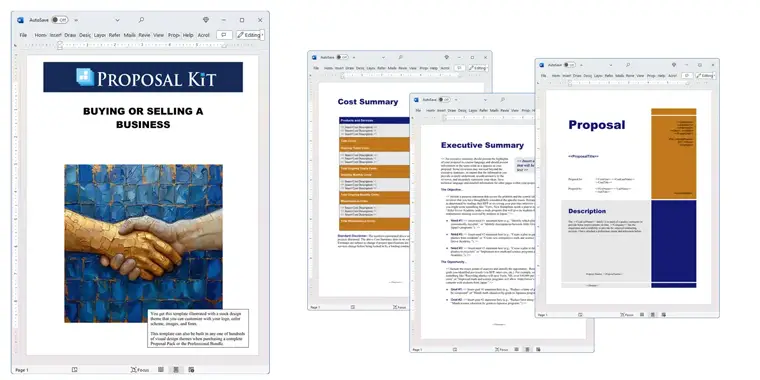How to write your Buying or Selling a Business
We include this 26 page layout with every Proposal Pack. If you want this template to have a different visual design theme than the one illustrated here, purchase any Proposal Pack design and create this template using the purchased design theme. This template is included in every Proposal Pack. If you get a Proposal Pack or the Professional, you can also make any variation of this template with different chapters to suit your needs.
We typically include more chapters in the templates than most people will need to give everyone more variety in the chapters they may need. You can trim down a long template by removing pages you do not need or combining multiple chapter topics into one page.
 DOWNLOADABLE, ONE-TIME COST, NO SUBSCRIPTION FEES
DOWNLOADABLE, ONE-TIME COST, NO SUBSCRIPTION FEESYou can also create countless variations of this document to suit your needs using the included library of 2200+ chapters if ordering a Proposal Pack or Professional.
 What Our Clients Say
What Our Clients SayA simple software tool to meet complex "Request for Proposal" requirements. I’ve used this on a few proposals, and haven’t found an easier solution."
ISC Services LLC
Related Article
Related Video
Related Templates
- Selling a Company and Assets Counter Offer Proposal
- Franchise Selling Proposal
- Sale of Training Business Proposal
- Sale of Business and Assets Proposal
- Selling a Web Site and Digital Assets Proposal
- Business Selling Shares of Company Proposal
- Buying a Vending Franchise Proposal
- Franchise Purchasing Proposal
- Acquisition Plan Proposal
- Bid Response to Purchase a Business
Writing Winning Proposals for Buying or Selling a Business with Proposal Kit
In the intricate process of buying or selling a business, presenting a well-structured proposal is crucial. Whether you're a seasoned business owner or a newcomer to writing proposals, the Proposal Kit software and template library provides an invaluable tool for navigating this complex task. A proposal to outline the sales pitch is just one of many tasks in the sale of a business.
Can You See Yourself in This Situation? Have you ever considered buying or selling a business and felt overwhelmed by the need to create a comprehensive and effective proposal?
The Best Way to Write a Proposal for Buying or Selling a Business
For those unfamiliar with proposal writing, the key to success lies in a clear, organized approach. Proposal Kit offers a comprehensive solution.
Easy-to-Use Templates: The software includes a vast array of templates covering every aspect of business transactions. These templates guide you in detailing the financials, assets, and operational aspects of the business in question.
Financial Integration: A critical feature of Proposal Kit is its line item quoting database system. This tool simplifies the creation of cost summaries, quotes, estimates, budgets, and other financial documents, essential in valuing a business for sale or purchase.
What Types of Projects Are Buying or Selling a Business Proposal Written For?
- Selling a family-owned restaurant along with its property.
- Buying a small e-commerce business.
- Merging two IT companies and consolidating assets.
- Liquidating assets of a closing retail store.
- Acquiring a manufacturing business with its machinery.
- Selling a mobile app development company.
- Purchasing a local gym with all its equipment.
- Divesting a subsidiary of a larger corporation.
- Acquiring a boutique hotel and its associated real estate.
- Selling a publishing house along with its intellectual property.
Chapters this template is built with
These are just a small set of chapter topics out the thousands available in the Proposal Kit library that can be incorporated into your custom proposal. Key templates that can be used in these proposals include the following.
Expanding on these topics using Proposal Kit templates ensures a comprehensive and detailed approach to writing proposals for buying or selling a business, thereby enhancing the proposal's clarity, effectiveness, and professional appeal.
These templates are just a glimpse into the extensive library available in Proposal Kit, allowing customization to fit any business scenario.
Non-Disclosure Form
The Non-Disclosure Form is a pivotal document in maintaining confidentiality during business negotiations. It legally binds all parties to keep the shared information private, thus protecting sensitive data such as business strategies, financial details, and client lists. This form ensures that discussions and negotiations can occur freely without the risk of information leakage, fostering a secure and trustworthy environment.
Executive Summary
This section serves as the proposal's introduction, succinctly presenting its main objectives and goals. It should encapsulate the essence of the transaction, outlining key points like the nature of the business, the purpose of the sale or purchase, and the main benefits for the involved parties. A well-written Executive Summary sets the tone for the proposal and encourages further reading by emphasizing the proposal's value and intent.
Opportunities
In this segment, highlight the potential growth and benefits arising from the transaction. Discuss how the acquisition or sale will open new market opportunities, increase revenue streams, or lead to operational efficiencies. For the selling party, this might involve illustrating how the business can scale under new ownership. For buyers, it could focus on the potential for integration with existing operations or exploration of new markets.
Valuation
Detailing the valuation process is crucial. This section should explain how the business's value was determined, incorporating methodologies like market comparisons, asset-based valuation, or earnings multiples. Justify the rationale behind the chosen method and include supporting data to provide a clear and convincing valuation narrative.
Financial Statement
The Financial Statement provides a comprehensive view of the business's financial health. It should include key financial documents like income statements, balance sheets, and cash flow statements. This snapshot of the company's financial performance offers insights into its profitability, liquidity, and financial stability, forming a critical part of the decision-making process for buyers.
Company History
Here, outline the business's background, key milestones, and its evolution over time. This narrative should include the founding story, major growth phases, market changes responded to, and any significant shifts in strategy or product offerings. This history helps to build a story around the business, adding depth and context to its current valuation and market position.
Assets
List all physical and digital assets included in the sale. Physical assets might include property, machinery, inventory, and vehicles, while digital assets could encompass websites, digital content, software, and databases. This comprehensive listing helps in assessing the tangible and intangible value being transferred in the transaction.
Intellectual Property
Detail any intellectual property (IP) associated with the business, such as patents, trademarks, copyrights, and trade secrets. This section should include the status (registered, pending, or unregistered) of each IP item, its significance to the business's operations, and how it contributes to the company's competitive advantage. Clearly defining the scope of the IP helps in understanding its value and potential legal considerations.
Personnel
Provide detailed information about the company's workforce, including the number of employees, their roles, expertise, and contributions to the business. Highlight key management personnel and their impact on the company's success. This section may also address the plan for personnel integration or changes post-transaction, which is crucial for buyers to understand the human resource dynamics of the acquisition.
Disclosures
This section includes any legal and financial disclosures relevant to the transaction. Legal disclosures may cover any ongoing litigations, regulatory compliance issues, or contractual obligations. Financial disclosures might include any debts, liens, or financial obligations that the business carries. Complete and transparent disclosures are vital for building trust and ensuring a smooth transaction process.
Use cases for this template
Selling an IT Business
Mia's journey with Digital Canvas Studio was one of passion and innovation. Under her leadership, the company had grown from a modest startup to a well-regarded player in the web and graphic design industry. However, when the time came to move onto new ventures, Mia faced the task of selling her business.
Turning to Proposal Kit for assistance, Mia meticulously cataloged every aspect of Digital Canvas Studio. She used the software to showcase her company's diverse portfolio, which included work for high-profile clients and innovative design projects. The client list she compiled was not just a roster of names but a testament to the company's reputation and market reach.
Mia's proposal also highlighted the digital assets, which were a cornerstone of the company's value. This included proprietary design software, licensed tools, and a rich database of client projects. Using Proposal Kit's financial templates, she was able to present a transparent and well-justified valuation of her business, which was backed by clear financial records and future earning potential.
The professionalism and depth of Mia's proposal drew the attention of several serious buyers, leading to competitive bids. Ultimately, her thorough preparation and detailed presentation resulted in a successful and profitable sale, marking a satisfying end to her chapter with Digital Canvas Studio.
Divesting Company Assets
Jordan, an employee at FuturEdge Corp., faced a critical challenge when he was assigned to oversee the divestiture of one of the company's divisions. The division in question was a cornerstone of innovative research and development, holding several valuable assets, including cutting-edge proprietary technology and patents.
With a strict deadline looming, Jordan leveraged the efficiency of Proposal Kit to create a compelling and comprehensive proposal. He meticulously detailed each asset, emphasizing their market value and potential for future development. The proposal outlined the technological advancements achieved by the division, the patents' significance, and their applicability in various industries.
Jordan's strategic use of Proposal Kit's templates enabled him to write a proposal that was not only thorough but also clearly communicated the value proposition of the assets. His ability to meet the tight deadline with a well-structured and persuasive proposal facilitated a smooth and beneficial divestiture for FuturEdge Corp., showcasing his skill and reliability as an invaluable asset to his company.
Purchasing a Small Business
Alex, the leader of VentureTech Solutions, was on a mission to expand the company's capabilities through strategic acquisitions. His target was a small, yet promising software development firm known for its innovative solutions and talented team.
Using the business acquisition template from Proposal Kit, Alex wrote a detailed proposal that not only outlined the financial aspects of the acquisition but also the strategic alignment between the two companies. He emphasized how the acquisition would complement VentureTech Solutions' existing services, opening new market opportunities and enhancing the company's technological edge.
The proposal laid out a clear plan for integrating the new firm into VentureTech Solutions, addressing potential challenges and showcasing the long-term benefits. Alex's attention to detail and strategic foresight, facilitated by the comprehensive structure provided by Proposal Kit, allowed him to present a convincing case to his board.
His well-thought-out proposal, backed by thorough research and clear financial projections, successfully persuaded the board of the acquisition's value. This strategic move marked a significant step in VentureTech Solutions' growth, positioning them as a more versatile and robust player in the technology sector.
Conclusions and Recommendations
Each situation demonstrates how Proposal Kit simplifies and enhances the process of writing proposals for buying or selling a business. From individual entrepreneurs to large corporations, users find value in the software's ability to create organized, detailed, and persuasive proposals.
Also Known As
This template may also be referred to in different ways or be used in more specialized situations, such as:
- Business Acquisition Proposal
- Business Divestiture Plan
- Company Purchase Proposal
- Business Sale Agreement Plan
- Enterprise Acquisition Strategy
- Business Transfer Proposal
- Company Sale Proposal
- Business Buyout Plan
- Business Ownership Transition Proposal
- Company Purchase and Sale Strategy
Abstract
 Navigating buying and selling businesses requires meticulous preparation and an approach. Proposal Kit offers invaluable tools for creating winning proposals, which is important for both potential buyers and sellers aiming to secure the best deal. The comprehensive templates and financial integration features simplify the complex processes involved, from setting the purchase price to outlining the deal structure. Users can efficiently prepare documents that detail acquired assets, tax considerations, and other critical topics such as due diligence and exit strategy. By using these tools, business owners and entrepreneurs can attract interested parties and maximize the likelihood of a successful transaction.
Navigating buying and selling businesses requires meticulous preparation and an approach. Proposal Kit offers invaluable tools for creating winning proposals, which is important for both potential buyers and sellers aiming to secure the best deal. The comprehensive templates and financial integration features simplify the complex processes involved, from setting the purchase price to outlining the deal structure. Users can efficiently prepare documents that detail acquired assets, tax considerations, and other critical topics such as due diligence and exit strategy. By using these tools, business owners and entrepreneurs can attract interested parties and maximize the likelihood of a successful transaction.
The Proposal Kit assists in preparing proposals that cater to various business situations, whether one is involved in an asset sale or a stock sale. The software supports users in addressing crucial family issues, financing options, and tax basis evaluations, ensuring all topics of the sale or purchase are comprehensively covered. Business brokers and potential buyers can contact sellers through these professionally structured documents, which include important topics like business plans, disclosures, and financial statements. The kit also provides advice for negotiating and deciding on the highest price or lump sum payments, aiding both parties in reaching a mutually beneficial deal.
Moreover, the Proposal Kit facilitates the preparation of documentation for several years of financial performance and planning. Its templates ensure that sellers can prove their business's worth, while buyers can assess risks and investment opportunities with clarity. By addressing shareholders' interests, tax implications, and legal considerations, the Proposal Kit minimizes uncertainties and protects both parties involved in the venture. This detailed approach not only attracts more potential buyers but also leads to a smoother and more clear transaction process.
 Proposal Kit further enhances the buying and selling process by offering a structured platform that supports various deal structures and negotiation stages. The software's templates help entrepreneurs and business owners systematically decide on the terms of the transaction, ensuring that both parties reach a fair asking price. By outlining the business's assets, potential growth opportunities, and financial health, sellers can make their businesses more attractive to buyers, increasing the likelihood of securing the highest price.
Proposal Kit further enhances the buying and selling process by offering a structured platform that supports various deal structures and negotiation stages. The software's templates help entrepreneurs and business owners systematically decide on the terms of the transaction, ensuring that both parties reach a fair asking price. By outlining the business's assets, potential growth opportunities, and financial health, sellers can make their businesses more attractive to buyers, increasing the likelihood of securing the highest price.
Potential buyers benefit from the detailed financial statements and company history included in these proposals, allowing them to make informed decisions about their investments. The integration of line item quoting systems helps estimate costs and determine the tax basis, which is crucial for evaluating the overall profitability of the deal. Proposal Kit also provides guidance on addressing issues that may arise during the buying or selling process, ensuring that all circumstances are considered.
The software supports users in creating a narrative around the business's strengths, from its market position to its innovative products or services. Sellers can highlight their competitive edge, while buyers can visualize how the acquisition aligns with their goals. Through clear disclosures and a comprehensive approach to due diligence, the Proposal Kit helps both parties bear any potential risks with confidence.
 In addition to facilitating traditional business sales, Proposal Kit is an invaluable tool for those involved in mergers, divestitures, and other complex transactions. Its templates cater to a wide range of industries, from tech startups to established franchises, and provide detailed instructions on how to prepare for each stage of the process. Users should also receive tips and advice on legal considerations, financing options, and other important topics with input from experienced bankers, accountants, and attorneys.
In addition to facilitating traditional business sales, Proposal Kit is an invaluable tool for those involved in mergers, divestitures, and other complex transactions. Its templates cater to a wide range of industries, from tech startups to established franchises, and provide detailed instructions on how to prepare for each stage of the process. Users should also receive tips and advice on legal considerations, financing options, and other important topics with input from experienced bankers, accountants, and attorneys.
By maximizing the use of Proposal Kit's features, business owners can ensure that their proposals are not only professionally presented but also sound. This attention to detail and comprehensive planning helps to protect their interests, minimize risks, and ultimately prove the value of their business venture. Whether preparing for a sale or an acquisition, Proposal Kit equips users with the tools needed to achieve a successful and profitable outcome.
Frequently Asked Questions
What should be included in a Buying or Selling a Business Proposal?
Essential elements include an executive summary, business overview, financial statements, valuation of the business, terms of the sale, due diligence documentation, timeline for the transaction, legal considerations, and a detailed action plan for the transition process.
How do I accurately value the business for the proposal?
Accurate valuation can be achieved by analyzing financial statements, considering market conditions, evaluating assets and liabilities, using valuation methods such as discounted cash flow or comparable company analysis, and consulting with financial experts or business appraisers.
What legal considerations should be addressed in the proposal?
Legal considerations include ensuring compliance with relevant laws and regulations, addressing tax implications, drafting clear and binding contracts, outlining terms and conditions of the sale, securing necessary permits and licenses, and consulting with legal professionals to avoid potential legal issues.
How can I effectively present the business's strengths and potential to prospective buyers?
Highlight the business's strengths, such as its financial performance, market position, competitive advantages, growth opportunities, customer base, operational efficiencies, and proprietary technology or intellectual property. Use visuals such as charts and graphs to support the narrative.
What are the best practices for conducting due diligence when buying or selling?
Best practices for due diligence include thoroughly reviewing financial records, assessing operational and legal aspects, evaluating management and employee structures, inspecting physical assets, analyzing market and competitive landscape, and verifying all information provided by the other party. Creating a comprehensive checklist and timeline for the due diligence process is crucial.
20% Off Discount
![]() Add To Cart This Word Template
Add To Cart This Word Template
 Add To Cart Proposal Pack for Any Business
Add To Cart Proposal Pack for Any Business
 Add To Cart Proposal Kit Professional
Add To Cart Proposal Kit Professional
 4.7 stars, based on 849 reviews
4.7 stars, based on 849 reviewsProposal Kit chapters used in this template
Cover Letter, Title Page, Table of Contents, Non-Disclosure Form (Long Version), Confidentiality, Executive Summary, Opportunities, Services Provided, Products, Property, Assets, Intellectual Property, Personnel, Market Share, Financial Statement, Revenue, Balance Sheet, Profit and Loss Statement, Cash Flow Analysis (3 Year), Outstanding Debts, Valuation, Summary, Disclosures, Company Operations, Company History, Back Page
Line Item Automated Chapters
If you purchase a Proposal Pack or the Professional Bundle, these proposal pages are generated using an automated line-item database in the included Wizard software.
Financial Statement, Balance Sheet Three Year, Profit and Loss Statement Three Year, Cash Flow Three Year, Debts
You use this proposal for
- General business proposal
- Non-technical proposal
- Buying and selling a business proposal
- Business opportunity, partnership proposal
- Food, beverage, catering, grocery proposal
- Franchising, vending proposal
How to create this template with Proposal Pack Wizard
You can create this document using any of the logo-designed Proposal Packs. Pick any Proposal Pack with a logo design theme you like best; they will all work equally well. The Proposal Pack for Any Business is the pack with no extra added logos or colors - designed to be used plain or for you to customize with your logos and graphics.
The Proposal Pack design theme you purchase will determine the visual look of this template. The screenshot above only shows the plain generic design theme.
We include a library of chapters to be assembled based on your needs. All proposals are different and have different needs and goals. We designed Proposal Pack so you can customize the documents to suit your needs.
You will best create this document using the Proposal Pack Wizard - Expert Edition software to select this template and build it in the Proposal Pack logo design theme of your choice along with any desired customizations (such as adding additional chapters, removing unneeded chapters, changing the order of chapters, and importing your company logo). This template outlines a proposal for the described situation. Each user is responsible for typing in the actual content of the provided pages with their information to complete the proposal. Suggestions in the abstract may include features in higher-end packages and are facilitated by the selection of chapter templates to support the narrative of each proposal, which help guide the user in filling in the details.
The Wizard software's AI Writer will write the content of the pages of the template based on details provided for your company, client, project, financial details and other writing instructions. This will provide a personalized version of the template completely written and ready to edit.
Once finished, the AI Writer's Word-to-PowerPoint converter can transform your proposal, business plan, or other business documents into a PowerPoint slideshow. Save time and effort by letting the AI analyze every chapter to condense its content into talking points, visually matching the document, and providing a consistent package of presentation material with the click of a button.
You create this template using the Wizard software with an entire Proposal Pack library and software. We include the Expert Edition of the software in the Proposal Kit Professional. Microsoft Word for Windows is required to use the customizing software. You can also edit Word document templates in other office software such as Word for Mac. We will assist Mac users in assembling complex templates for their first project if they do not have the required platform to run the Wizard software.
How to Build Templates Featured on Proposal Kit Website
Many people find the Proposal Kit website after searching for a specific proposal. Once you've purchased and installed the software, how do you build that template you found in the first place? This video shows you how to build any proposal you see on the Proposal Kit website.
 Ian Lauder has been helping businesses write their proposals and contracts for two decades. Ian is the owner and founder of Proposal Kit, one of the original sources of business proposal and contract software products started in 1997.
Ian Lauder has been helping businesses write their proposals and contracts for two decades. Ian is the owner and founder of Proposal Kit, one of the original sources of business proposal and contract software products started in 1997.By Ian Lauder
 Published by Proposal Kit, Inc.
Published by Proposal Kit, Inc.


 Cart
Cart
 Get 20% off ordering today:
Get 20% off ordering today: 


 Facebook
Facebook YouTube
YouTube Bluesky
Bluesky Search Site
Search Site